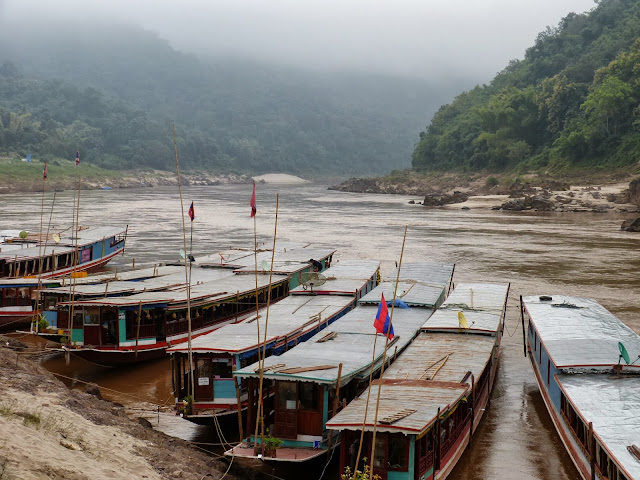(We've put a bit more detail into this post to help other travelers through this tricky border crossing. We had met people along the way that were planning to cross by motorbike! Read on to see why this would not be a good idea.)
We had read that Lak Xao was a popular stop-over town for tourists making the Laos Vietnam border crossing from Vientiane to Hanoi. After our 7 hour ride on a local bus (85,000 kip each from Don Dok/ Southern Bus Station) we arrived at a small almost deserted and certainly not tourist friendly settlement at the foot of a towering mountain.
_3.JPG) |
| Lak Xao |
We were actually surprised to stumble across a visitors' centre. The last entry in the log had been 6 weeks prior. The staff spoke limited english and could offer little advice for ongoing transport but they were certainly pleased to see us and practice their english. They directed us to one of the few guesthouses, which gave the impression of an old logging mansion with ornate wooden floors, ceilings and a sweeping staircase. We seemed to be their only guests.
The following morning we attempted to travel the final 34km (1 hour) on towards the border and we were forced to take a tuk tuk (bartered down to 60,000 kip for two) after we were told that buses could not pass. This made more sense when we discovered that further along the roads were wrecked by hundreds of slips, the ground saturated and on the move. We had transitioned from dry plains to misty mountains. The Laos exit and Vietnam entry points (only a few hundred meters apart) were isolated and staff also spoke little english. The exchange rate at the Laos immigration office was better than expected and we swapped the last of our kip for dong, acutely aware that kip could not be exchanged out of the country. We waited in queues of locals to get our visas checked and stamped (our Vietnam visa was pre-purchased in Bangkok) and paid a small extra fee of 20,000 dong each on the Vietnamese side for what we assumed to be administration.
Despite the language barrier, we stuck with some local boys and were hustled from vehicle to vehicle while we traversed the rougher terrain (at no cost, some sort of temporary shuttle service it appeared). We completed the worst areas on foot, climbing down muddy sections whilst helping the local travelers carry their heavy bags of rice (along with our backpacks!). The risk of further slips seemed imminent and in some parts we could see the slopes moving beside us. Despite this, lots of official looking Vietnamese men stood around in trenchcoats and green pith helmets.
 |
| Marc Helping the Local Boys |
 |
| Damaged Roads, Nam Phao Border Crossing |
We then faced a 4 hour long drive (US$10 each) over some of the roughest roads we had experienced (yet more evidence of recent heavy flooding), to reach Vinh (pronounced Ving). Whilst the van drivers seemed a bit rough, smoked heavily and drove with disregard to the road conditions, we felt safe enough and the locals appeared to pay the same rate as we did.
Vinh city has been dubbed "grim Vinh" for it's bleak appearance and artless concrete buildings. Vinh was so heavily bombed during the American War that it was reduced to two buildings and a population of zero in the year 1972. Considering this, it still gave an impression of a substantial city with it's fair share of high rise hotels and extreme noise pollution (which we soon learnt was standard in Vietnam where hooters are used at every opportunity). Not appealing for longer than a quick stop-over, we spent only one night before hopping on the train for a long ride north to Hanoi.




.jpg)




_3.JPG)







































